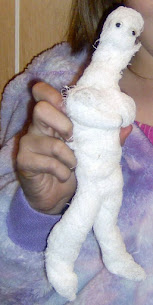 |
| Halloween watercolor painting |
We love Halloween!
Our young artists always look forward to spooky, creepy, scary arts & crafts-making, and who can blame them???
Not me. I feel the same way.
Here are some very spooky projects we created this Halloween, and how you can make them too.
Wacky Witch's Legs!
This painted collage is so much fun to make!
First you paint the stripy background. We used cake tempera paint for this.
While the background dries, you cut out and assemble the legs and the witchy dress and shoes.
We used lots of sparkly washi tape and sequins for some extra 'stylin' on our witch's big night!
We got this great idea from A Faithful Attempt, where you'll find the full instructions for this great Halloween mixed media project!
We make these mummies every year for Halloween.
They are super bendy, so they can display any mood or assume any position!
You never know where you will find your mummy!
One young artist said her mummy is just like a spooky Elf on the Shelf!
Visit Crate and Barrel Kids for step-by-steps to make your own Moveable Mummy.
Do you have some scrap lumber laying around? I cut a few 2 x 4 scraps into square blocks and viola! Halloween Blockheads!!!
All you need are a few random art supplies, craft paint, and glue. We used fun foam, twigs, artificial leaves, craft sticks, pipe cleaners, googly eyes, feathers, and anything else we had on hand.

















































